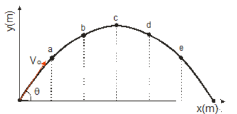Multiple Choice
Use the figure to answer the question.
The figure represents the parabolic trajectory of a ball going from a to e in Earth gravity but without air resistance. The initial velocity of the ball is Vo at an angle  to the horizon. The vertical dashed lines represent equal time interval,
to the horizon. The vertical dashed lines represent equal time interval, 

-The horizontal velocity at point c is
A) 0
B) Vo cos ( )
C) Vo sin ( )
D) Vo
E) depends on what g is along the path
Correct Answer:

Verified
Correct Answer:
Verified
Q2: A merry-go-round completes one revolution in
Q3: A car is at position (x<sub>1</sub>,y<sub>1</sub>)= (4
Q4: Use the following to answer the question:
Q5: A stone with a mass m is
Q6: A projectile is ejected from a 25-m
Q8: The displacement of a particle is _
Q9: A car is traveling east at 50
Q10: Use the figure to answer the question.<br>The
Q11: Use the figure to answer the
Q12: A projectile is fired with an initial